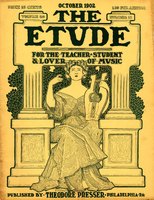The writer of these columns feels constrained to make a confession which will probably amuse many of his readers.
During the past twelve months or more he has been the recipient of many anxious inquiries regarding the probable genuineness of instruments possessed by the writers of these letters—instruments described by their owners with a pathetic devotion to details of varnish and structure, and, in most cases, naïvely offered to him at the price of valuable real estate. Curiously enough, these fiddles (according to their owners’ descriptions) bore to one another the most remarkable family resemblances; and the circumstances surrounding their earlier history, as well as the manner in which they reached their latest abiding-place, differed only in insignificant details.
But the characteristic feature of all these instruments, the one that seemed to convince their possessors that theirs was the simon-pure article, was the dust-laden, mystic label barely visible through the F-holes. As a rule, this label bore the date “1716”—a period in the world’s history sufficiently remote to excite interest, if not fervid expectations. It is this label that is responsible for the present writer’s predicament and his humiliating confession.
Having an honest wish to spare inexperienced owners of “Strads” of the 1716 variety the disappointment, or even anguish, usually experienced by those who are disillusioned after believing for many years that their fiddles are genuine “Strads,” and growing weary, too, of the increasing number of remarkable requests made of him by heedless possessors of worthless instruments, the editor at last conceived the idea of summing up his past experiences in a brief article which was intended to show the absurdity of accepting a mere printed label as a guarantee of the artistic worth of an instrument. This article appeared in the August issue of The Etude, and told the ridiculous story of “Mrs. X—‘s Discovery.” But instead of relieving the editor of importunate requests, or giving his readers a more correct idea of the actual worth of a printed label that pronounces a fiddle to be the work of a great master, this article has been taken seriously by several persons, who are enjoying a brief ecstasy in the belief that “Mrs. X—” was the possessor of a genuine “Strad,” and that she actually discovered the true way of testing its antiquity.
The editor humbly makes confession of his serious blunder. He forgot to add, at the conclusion of his article, “Mrs. X—‘s Discovery is only a Midsummer Joke.” He did not realize that an intimate connection might possibly arise between his attempt at humor and a surgical operation. He related a few absurdities in order more forcibly to present the truth; but in several instances the truth has remained unperceived, and the absurdities that were utilized in a worthy cause have been swallowed without hesitation and, apparently, without impairing the digestion of the new correspondents.
In all seriousness, we urge our readers speedily to rid themselves of the label mania. Labels, nowadays, are manufactured by the thousand, and pasted inside of most fiddles that bear even the slightest structural resemblance to the instruments made by Stradivarius. The date selected for many of these labels seems to be 1716—a year chosen, in all probability, because the period which it represents marked Stradivari’s greatest achievements. But the majority of the violins that bear such a label are nothing better than machine-made instruments easily obtainable for twenty dollars or less.
We may now reasonably hope that our readers will understand that most labels are nothing better than shams, delusions, and snares. And again let it be said:
Mrs. X—‘s Discovery
is only
A Midsummer JOKE.



